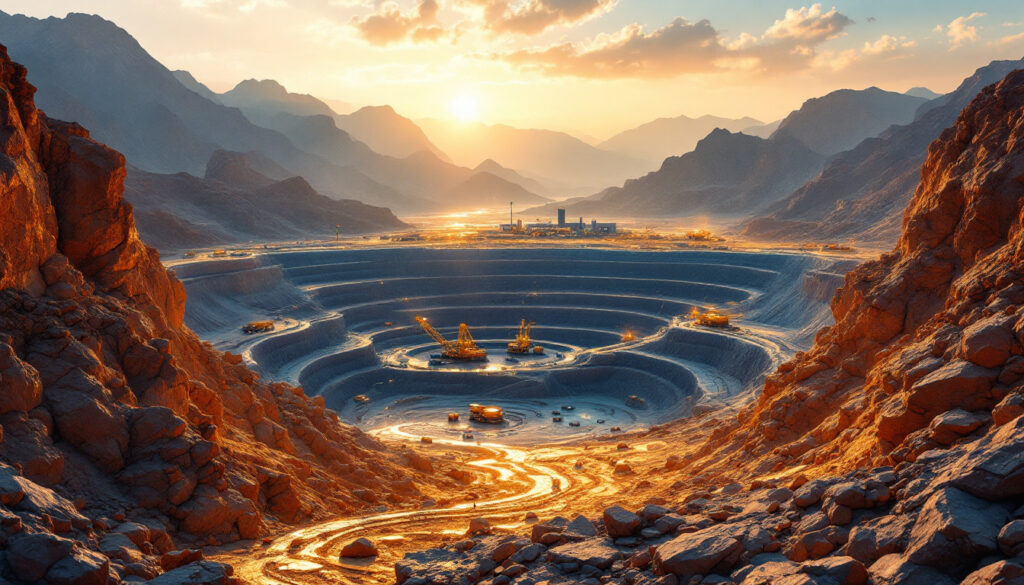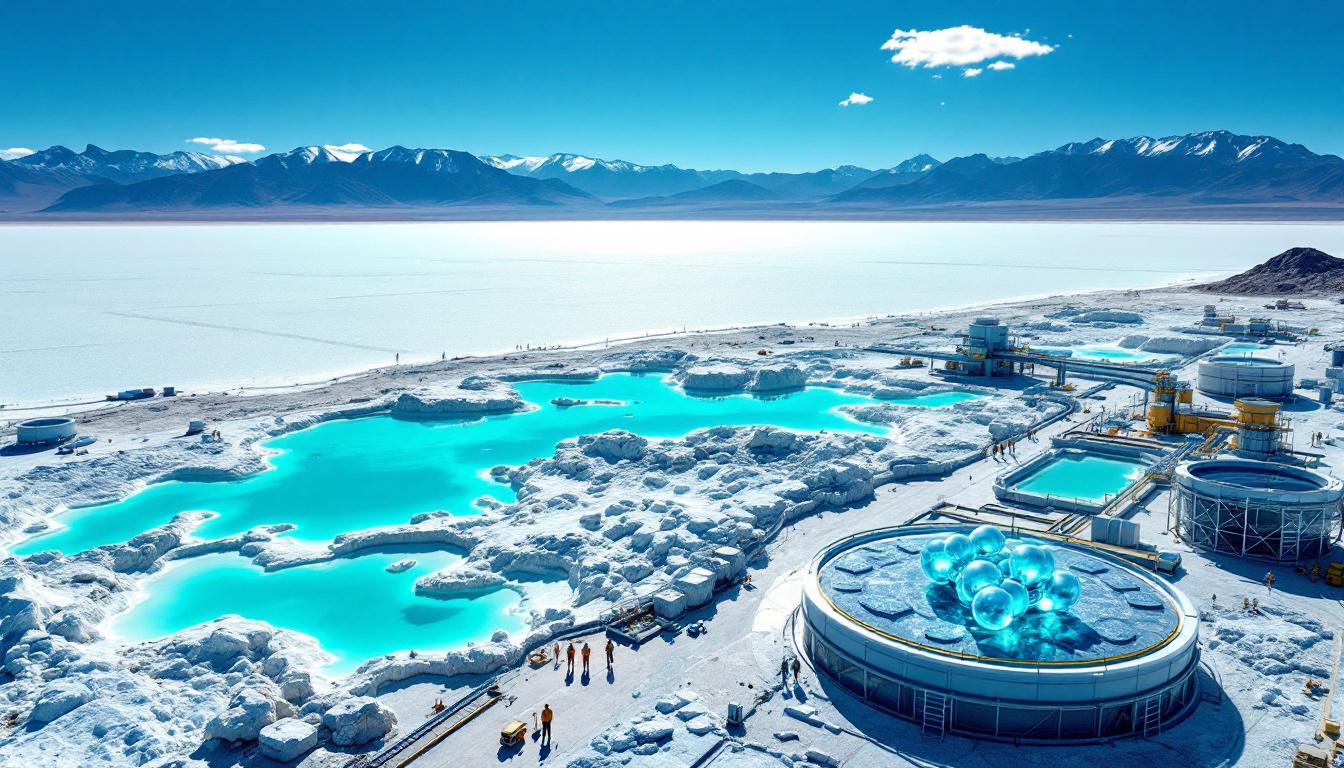Barrick Gold's Reko Diq Project: Financing Strategy and Global Impact
Barrick Gold's Reko Diq project stands as one of the largest undeveloped copper-gold deposits globally, representing a pivotal turning point not only for the mining giant but also for Pakistan's economic landscape. The massive project, jointly owned by Barrick Gold and the governments of Pakistan and Balochistan, is projected to generate over $70 billion in free cash flow and $90 billion in operating cash flow over its lifetime. With its revised mine lifespan of 37 years and potential extension to 80 years given unaccounted mineral resources, Reko Diq has become the cornerstone of Barrick's strategic pivot toward copper.
Understanding the Reko Diq Project
The Reko Diq project has recently undergone significant revisions following comprehensive feasibility studies insights. Phase one throughput has been increased to 45 million tonnes per year, up from the initially planned 40 million tonnes. Similarly, phase two projections now aim to process 90 million tonnes annually, a substantial increase from the original 80 million tonne estimate. These expanded processing capacities reflect the project's enormous potential but have also necessitated cost revisions.
The estimated cost for phase one has been revised upward from $4 billion to $5.6 billion, representing a 40% increase. Despite this higher initial investment, Barrick remains committed to beginning production by 2028, indicating strong confidence in the project's long-term economics. The scale of Reko Diq becomes apparent when considering that its projected $90 billion in operating cash flow exceeds the market capitalization of most mining companies globally.
The deposit's exceptional grade profile combines substantial copper reserves with significant gold credits, creating a dual-revenue stream that enhances project economics even during periods of copper price volatility. Geological analysis indicates that the resource may extend well beyond current estimations, which explains the potential for the mine life to stretch toward 80 years with future exploration.
How Is Barrick Financing the Reko Diq Project?
Securing adequate financing for a project of Reko Diq's magnitude represents a significant challenge, even for a company of Barrick's stature. The mining giant is currently seeking more than $2 billion in total financing, with term sheets expected to be finalized by early Q3 2025. According to Tim Cribb, Reko Diq's Project Director, "We expect to close the term sheet in either late Q2 or early Q3," highlighting the advanced stage of these negotiations.
Multiple international lenders have expressed interest in backing this strategic asset. The International Finance Corporation and International Development Association have committed approximately $650 million to the project. Meanwhile, the US Export-Import Bank is considering a substantial contribution ranging between $500 million and $1 billion, underscoring the project's strategic importance to American interests in the region.
Additional development finance institutions, including the Asian Development Bank, Export Development Canada, and Japan Bank for International Cooperation, are collectively providing around $500 million. This diverse consortium of international financiers demonstrates broad confidence in both the project's economics and Barrick's operational expertise.
The World Bank's involvement extends beyond direct project financing to creating a supportive investment environment. The institution has pledged $2 billion annually for Pakistan's infrastructure development over the next decade, which will indirectly benefit Reko Diq through improved transportation networks, power infrastructure, and regional stability. This commitment creates a favorable environment for international development financing and helps mitigate some of the logistical challenges inherent to operating in Balochistan.
Offtake Agreements and Market Strategy
Strategic offtake agreements form another critical component of Reko Diq's financing and operational strategy. Barrick is actively negotiating with potential copper buyers across Asia and Europe, with particular interest from Japan, South Korea, Sweden, and Germany. These industrialized nations face growing concerns about copper supply security amid electrification trends and renewable energy transitions.
The strategic importance of these offtake agreements cannot be overstated. They are expected to be secured as part of the financing terms, providing lenders with additional confidence by guaranteeing future revenue streams. Long-term offtake deals are critical for lenders to mitigate price volatility risks, especially given the substantial capital at stake.
Industry experts note that competition for securing long-term copper supply has intensified, with major economies prioritizing supply chain security for critical minerals. Reko Diq's substantial production capacity, estimated at 250,000 tonnes per year at full operation, positions it as a desirable partner for industrial nations seeking to reduce dependency on Chinese-controlled copper sources.
The offtake agreements will likely include price floors and ceilings to protect both Barrick and buyers from extreme market fluctuations, while still allowing for reasonable participation in copper price appreciation. This balanced approach helps make project financing viable while maintaining long-term upside potential for shareholders.
Why Is Reko Diq Central to Barrick's Corporate Strategy?
Under CEO Mark Bristow's leadership, Barrick has undertaken a strategic pivot toward copper, with Reko Diq representing the centerpiece of this transformation. Bristow's long-standing interest in expanding Barrick's copper portfolio is evidenced by previous exploration of takeovers of copper giants such as Freeport-McMoRan and First Quantum Minerals. The strategic shift has become so fundamental that the company has proposed changing its name from "Barrick Gold" to "Barrick Mining Corp," signaling a broader commodity focus.
Mining analyst Carey MacRury of Canaccord Genuity Group observes, "Barrick's just really interested in copper now," adding that the company "hasn't bought or built anything in gold since Bristow took over." This statement underscores how dramatically Barrick's strategic priorities have shifted under current leadership.
Reko Diq represents more than just another mine in Barrick's portfolio—it embodies the company's vision for future growth in a global economy increasingly dependent on copper. Currently, copper contributes less than 10% to Barrick's revenue, but with Reko Diq and other copper projects in development, this proportion could exceed 25% by the early 2030s.
The pivot toward copper aligns with macroeconomic forecasts predicting a significant supply deficit by 2035. Industry specialists at CRU Group project a copper supply gap of approximately 8.5 million tonnes by that year, driven by electrification, renewable energy integration, and infrastructure modernization across developing economies. By establishing a major position in copper now, Barrick aims to capitalize on this projected supply-demand imbalance.
What Are the Economic Implications of the Reko Diq Project?
The economic implications of the Reko Diq project extend far beyond Barrick's corporate balance sheet. With production targeted to begin in 2028 and expanded throughput capacity in both phases, the project will create approximately 8,000 jobs during construction and support 4,000 operational roles throughout its multi-decade lifespan. For Pakistan's Balochistan province, historically one of the country's most economically challenged regions, this represents transformative investment.
The project constitutes the largest foreign direct investment in Pakistan's mining sector, accounting for approximately 80% of total mining FDI. This scale of investment sends positive signals to other potential international investors considering Pakistan as a destination for capital deployment. The tax and royalty structures, including a 5% royalty to the Balochistan government under the revised agreement, will provide substantial and steady revenue to local and national authorities.
Reko Diq's development aligns strategically with the World Bank's broader infrastructure development plans for Pakistan. As transportation networks, power generation, and water management systems improve to support mining operations, surrounding communities will benefit from enhanced infrastructure and services. This creates a virtuous cycle of development that extends beyond the mine itself.
Historical examples from other countries demonstrate how transformative such projects can be. Chile's copper-driven economic transformation from the 1970s through the 2000s provides a compelling case study of how responsibly managed mineral resources can elevate national prosperity. Similarly, Mongolia's experience with the Oyu Tolgoi copper-gold mine—though not without challenges—has significantly contributed to GDP growth and skills development.
FAQ About Barrick Gold and Reko Diq Financing
What is the total estimated cost of the Reko Diq project?
Phase one is now estimated at $5.6 billion, reflecting a substantial increase from the previous estimate of $4 billion. While the total project cost across all phases hasn't been explicitly stated in recent communications, industry analysts project the complete development could require investment approaching $15 billion over its multi-decade implementation. The revised costs reflect both expanded processing capacity and inflationary pressures affecting global mining projects.
How does this financing strategy compare to other major mining projects?
Reko Diq's financing approach demonstrates exceptional breadth of institutional support compared to peer projects. While many large mining developments rely heavily on corporate balance sheets and commercial bank lending, Barrick has secured significant commitments from development finance institutions. This diversified approach reduces dependency on any single funding source and leverages specialized expertise in emerging market project finance.
The involvement of export credit agencies like the US Export-Import Bank also distinguishes this financing package, potentially securing preferential terms for equipment procurement from American suppliers. Similar successful models have been employed at Kamoa-Kakula in the Democratic Republic of Congo and Quebrada Blanca Phase 2 in Chile, though Reko Diq's institutional lending component appears more substantial than these comparable developments.
What risks could affect the financing timeline?
Several factors could influence the financing timeline, including geopolitical considerations in Pakistan's Balochistan province, which has historically experienced security challenges. Global market conditions for copper and gold remain another variable, with recent copper price volatility potentially affecting lender confidence. The regulatory and environmental approval processes, while advancing steadily, could experience delays, particularly given the project's expanded throughput and consequent environmental footprint.
Currency risks represent another consideration, given Pakistan's macroeconomic volatility. Lenders will likely require robust hedging strategies to mitigate exposure to the Pakistani rupee. US-China rivalry in Pakistan, particularly regarding China's substantial investments through the China-Pakistan Economic Corridor (CPEC), adds another layer of geopolitical complexity that financiers must navigate.
What is the expected return on investment for the Reko Diq project?
The project is projected to generate over $70 billion in free cash flow and $90 billion in operating cash flow over its lifetime. These extraordinary figures reflect both the scale and grade quality of the deposit. The return profiles would naturally depend on copper and gold price assumptions, with current models likely using conservative long-term copper price projections around $4.00-4.50 per pound.
Sensitivity analyses suggest the project remains economically viable even with copper prices as low as $3.50 per pound, while offering substantial upside potential at prices exceeding $5.00 per pound. Gold credits provide additional revenue stability, effectively lowering the operation's position on the global copper cost curve.
Global Copper Market Outlook and Reko Diq's Position
The global copper market insights reveal dynamic structural changes driven by energy transition demands and industrial electrification. Strong industrial demand persists from Asian markets, particularly China's manufacturing sector, while European consumers increasingly prioritize supply security for renewable energy infrastructure and electric vehicle production. Countries across both regions are actively seeking to secure long-term supply agreements with reliable producers operating in stable jurisdictions.
Reko Diq will enter production during what many analysts predict will be a period of significant copper supply constraints. By 2028, when the project is scheduled to begin operations, several major existing copper mines will face declining grades and increasing production costs. This timing positions Barrick to benefit from potentially favorable pricing environments while offering buyers much-needed supply security.
The project's anticipated production of 250,000 tonnes annually at full capacity represents approximately 1% of global copper production. While this percentage may seem modest, within the context of new high-quality copper developments, it stands as one of the most significant additions to global supply expected this decade. The operation's projected position on the lower half of the global cost curve, enhanced by gold by-product credits, should ensure competitiveness even during periods of price weakness.
Reko Diq's strategic location provides certain logistical advantages for serving Asian markets compared to South American producers. Proximity to Chinese, Japanese, and Korean smelters reduces shipping costs and times, potentially commanding premium pricing for its concentrate. This geographical advantage, combined with the project's scale and grade quality, positions Reko Diq as a transformative asset not only for Barrick Gold but for the broader global commodities insights landscape.
Furthermore, the investment timing aligns well with emerging commodity super-cycle trends that many analysts predict will benefit copper producers well into the 2030s. The project's financing structure also demonstrates Barrick's sophisticated approach to strategic cash management that balances capital allocation needs with shareholder returns.
Ready to Spot the Next Major Mineral Discovery?
Discover significant ASX mineral discoveries before the market with Discovery Alert's proprietary Discovery IQ model, which transforms complex mineral data into actionable investment insights. Explore why major discoveries like Barrick's Reko Diq can generate extraordinary returns by visiting Discovery Alert's dedicated discoveries page.




